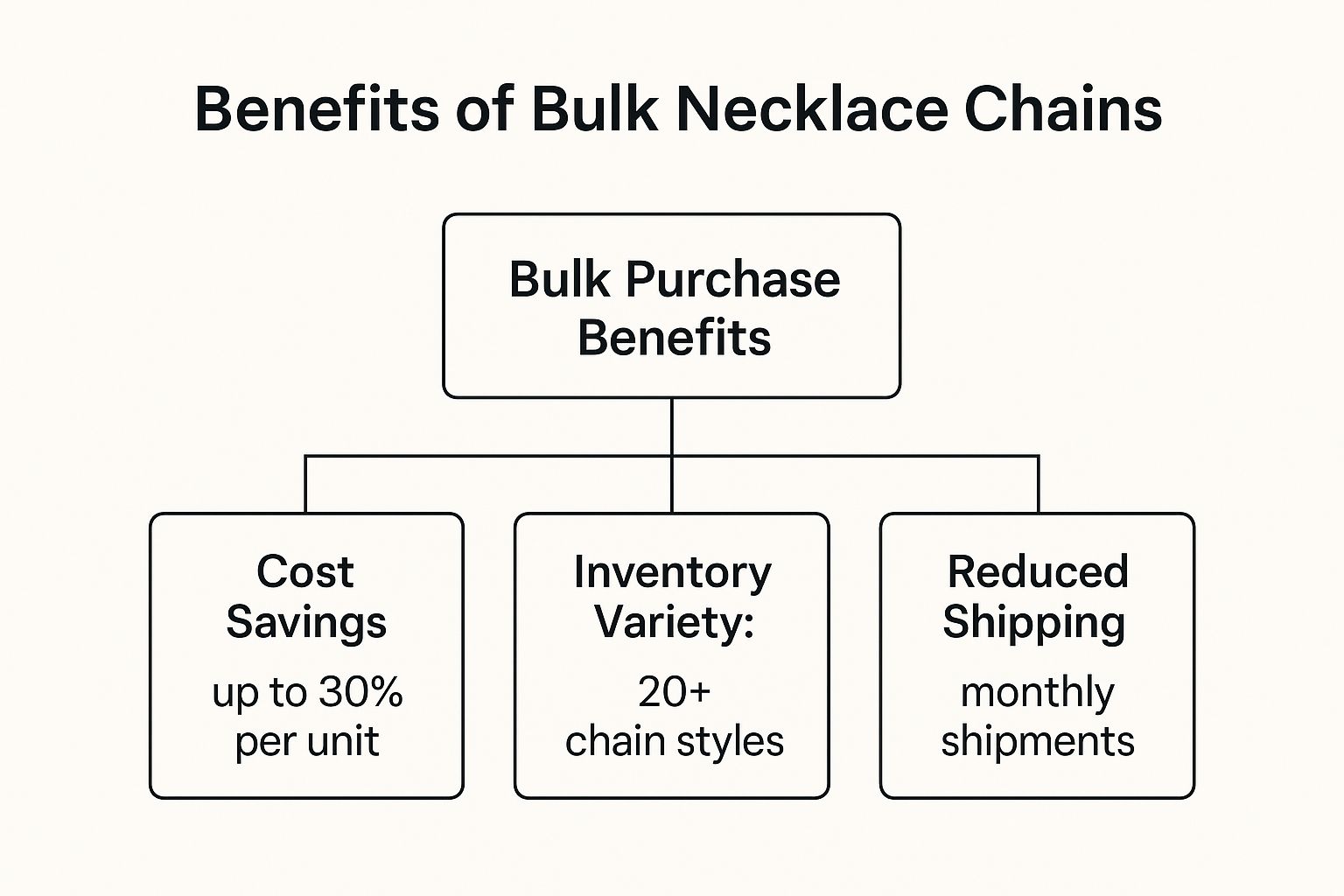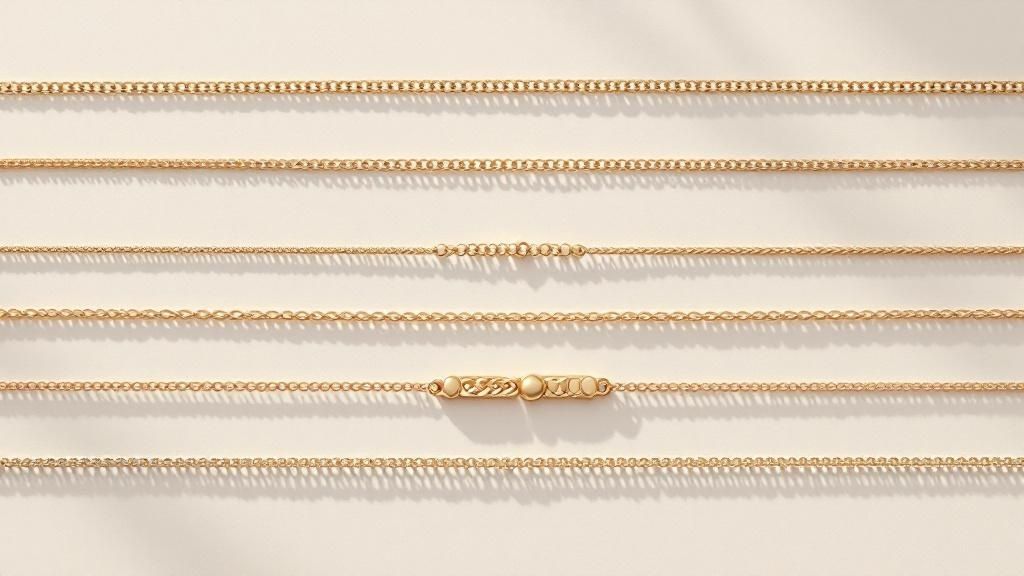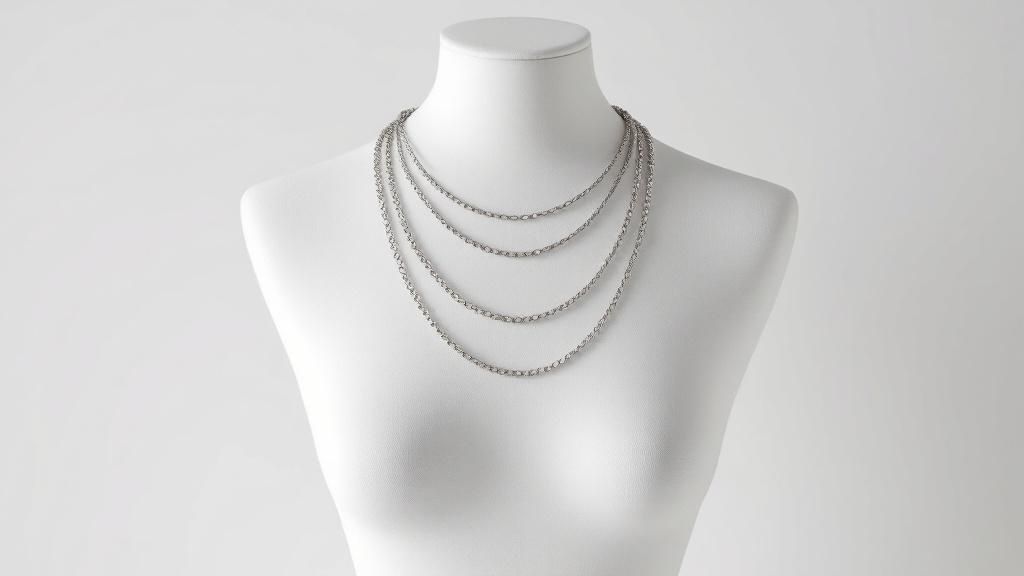Arthur Lynch | Tue Jul 29 2025
Your Guide to Buying Bulk Necklace Chains
Buying bulk necklace chains is more than a cost-saving move—it's a critical strategic decision for your jewelry business. For designers, makers, and retailers, effective sourcing directly impacts your brand's quality, profit margins, and customer loyalty.
Why Smart Sourcing of Bulk Chains Matters

Think of necklace chains as the canvas for your art. The right choice does more than hold a pendant; it sets the stage for your entire design. This isn't about finding the lowest price—it's about making a strategic choice that defines your brand's quality and helps you avoid costly problems like tarnishing, breakage, and customer complaints. A smart sourcing strategy ensures your finished pieces feel substantial, look professional, and earn trust from the moment they are worn.
Getting this right is more crucial than ever. The global jewelry market, where bulk chains are a core component, was valued at a staggering USD 366.79 billion in 2024. Experts predict it will surge to USD 578.45 billion by 2033, driven by personalized fashion and e-commerce. This growth is a huge opportunity, but only for businesses that master their supply chain. You can dive deeper into these numbers and consumer trends by exploring market analysis from sources like Grand View Research.
Building Your Foundation for Success
The quality of your chains speaks volumes about your brand's value. A flimsy, cheap-feeling chain can instantly devalue a beautiful pendant, leading to returns and a damaged reputation. Conversely, a well-chosen, high-quality chain elevates the entire piece, making it feel more luxurious and valuable.
Strategic sourcing is the art of balancing cost, quality, and aesthetics. It’s not about finding the cheapest option, but the best value that aligns with your brand’s promise to its customers.
Use this guide as your roadmap for building a reliable supply chain. We’ll walk through the practical, actionable steps you need to take. Here’s what you will learn to do:
- Decode Chain Styles: Move beyond names to understand which styles fit your brand’s personality and meet your design needs.
- Select the Right Materials: Make confident choices between popular options like stainless steel, sterling silver, and gold-filled chains based on performance and price.
- Master Technical Details: Grasp how specifics like gauge and length impact a necklace’s durability, drape, and overall appearance.
- Vet Wholesale Suppliers: Learn the practical steps for identifying a great supplier and building partnerships that deliver consistent quality.
By the end, you'll have the confidence to source bulk necklace chains like a pro, creating beautiful jewelry that your customers will love and wear for years.
Matching Chain Styles to Your Brand
Choosing the right necklace chain is like casting the lead actor for your jewelry line—it sets the tone and determines how customers perceive the final piece. Instead of memorizing names, let's analyze styles from a practical, design-focused perspective. This will help you select bulk necklace chains that fit your brand and the functional demands of your jewelry.
A classic Curb chain, with its interlocking, flattened links, offers a substantial, timeless look. Actionable Insight: Use this style to support bold, heavy pendants or to create masculine-style jewelry. It immediately communicates strength and durability, making it a reliable choice for statement pieces.
In contrast, the delicate Cable chain acts as the subtle supporting actor. Its simple, uniform oval links provide a minimalist feel. Actionable Insight: Choose this chain for small, lightweight pendants where the focus must remain squarely on the charm.
This visual breakdown highlights the business logic behind sourcing diverse styles in bulk.

As you can see, buying in bulk isn't just about inventory. It directly boosts your bottom line and expands your creative options, with potential cost savings of up to 30% per unit and access to over 20 unique styles.
Aligning Style With Function and Feel
Once you understand the basics, you can explore other styles that define your brand’s identity. It’s critical to understand how a chain's construction affects its look and performance. Some styles are more prone to kinking or twisting, a crucial detail for customer satisfaction.
A chain’s style is its personality. A modern, sleek Box chain tells a different story than an ornate, classic Figaro chain. Your job is to pick the personality that best represents your brand and complements your specific designs.
To make an informed decision, use this quick reference table. It provides a snapshot of what makes each style unique and what designs they are best suited for.
Quick Guide to Common Necklace Chain Styles
| Chain Style | Visual Characteristic | Best For | Durability Notes |
|---|---|---|---|
| Box Chain | Square links creating a smooth, modern line | Small to medium pendants; contemporary looks | Very sturdy and resistant to kinking |
| Rope Chain | Interwoven links resembling a real rope | Wearing solo as a statement; luxurious designs | Looks beautiful and textured, but can be prone to kinking |
| Figaro Chain | Pattern of small round links and one long oval link | Classic, slightly ornate styles; works alone or with a pendant | Generally durable and a timeless choice |
| Snake Chain | Tightly linked plates forming a smooth, flexible tube | Modern and fluid designs; great for showcasing pendants | Very sleek, but can be permanently damaged if bent sharply |
Thinking through these practical details is what separates good jewelry from great jewelry. Choosing a Box chain for its clean lines or a Figaro chain for its Italian-inspired flair says something about your brand. For a comprehensive look at the possibilities, you can explore a wide assortment of chain necklaces to find the perfect match. Making an informed choice ensures your pieces don't just look fantastic, but also wear beautifully for years.
Choosing Materials That Align with Quality and Price

The material you choose for your bulk necklace chains is a silent promise to your customer about your brand's value, durability, and quality. The key is to balance the cost of goods with customer expectations to build a profitable business without compromising your reputation.
Your material choice is the foundation of your brand's identity. A brass chain might be perfect for a trendy, fast-fashion line where affordability is key. However, if your brand emphasizes timeless appeal and longevity, a hypoallergenic stainless steel or classic sterling silver chain is a much better match. Every material has its own set of practical trade-offs.
A chain that tarnishes quickly or causes a skin reaction leads directly to negative reviews and a damaged brand. Your goal is to make a strategic decision that aligns with your target audience and the final price point of your jewelry.
Balancing Cost and Durability
The central challenge for any jewelry business is finding the sweet spot between a material's cost and its real-world performance. Some materials offer an easy entry point for new brands, while others require a higher upfront investment but deliver premium quality that customers can feel.
Here's an actionable breakdown of the most common options:
- Brass: A cost-effective alloy of copper and zinc, ideal for fashion jewelry. Actionable Insight: Use brass for trend-driven pieces with a lower price point, but be aware of its tendency to tarnish and potential for causing skin reactions.
- Stainless Steel: A fantastic middle-ground choice, celebrated for its strength, durability, and hypoallergenic properties. Actionable Insight: Choose stainless steel for everyday jewelry to offer customers a tarnish-resistant, rust-proof, and durable option.
- Sterling Silver: Marked with a ".925" stamp (92.5% pure silver), it has a premium look. Actionable Insight: Select sterling silver for classic, high-value pieces, but inform customers that it requires occasional polishing to maintain its shine.
- Gold-Filled: A thick layer of real gold mechanically bonded to a base metal core. Actionable Insight: Use gold-filled chains to provide the look and durability of solid gold at a more accessible price point, clearly distinguishing it from lower-quality gold plating.
Choosing the right material builds brand trust. For designers prioritizing toughness and hypoallergenic properties, sourcing from a wide collection of stainless steel jewelry is a practical way to deliver value and ensure customer satisfaction.
The Role of Plating and Finishes
The base metal is just the beginning. The plating or finish dramatically alters a chain's final look, lifespan, and cost. Plating is the process of covering a base metal with a thin layer of another, often more precious, metal.
Think of plating like the final coat of paint on a house. It dictates the color and provides the first line of defense against the weather. But the quality of that paint job determines how long it will be before it starts to chip and fade.
For example, rhodium plating over sterling silver gives it a bright, white finish and provides excellent tarnish resistance. Gold plating over brass or stainless steel can create a luxe look for a fraction of the price.
Actionable Insight: Always ask your supplier about plating thickness, usually measured in microns. A thin "flash plating" may look good initially but wears off quickly. A thicker, higher-quality plating (e.g., 1-3 microns) will last much longer. This detail directly impacts your customers' perception of your product's quality and longevity.
Getting Gauge and Length Right Every Time
Once you’ve settled on style and material, you must dial in the technical details of gauge and length. These specifications are fundamental to creating pieces that are balanced, durable, and comfortable. If you’re buying necklace chains in bulk, mastering these specs is non-negotiable.
Chain gauge is like the thickness of a thread. You wouldn't use a delicate thread to sew a heavy canvas bag. A chain's gauge, measured in millimeters (mm), determines its strength and visual weight. A dainty 1mm chain is perfect for a tiny charm but would look lost and risk snapping under a chunky pendant.
Your goal is to find that sweet spot—a harmonious balance where the chain is strong enough for the pendant but not so thick it overpowers the design. This isn't just a technical choice; it's a core part of your artistic vision.
Getting this right from the start saves you from the headache of customer complaints about broken chains and makes your designs look polished and professional.
Matching Gauge to Your Designs
When sourcing bulk necklace chains, you'll find gauges from under 1mm to over 5mm. As a practical rule, start by matching the gauge to your pendant's size and weight.
- Actionable Insight for 1mm - 1.5mm: Use this gauge for delicate, minimalist pieces like tiny birthstone charms or initial pendants. It’s also ideal for a simple, barely-there look when worn alone.
- Actionable Insight for 2mm - 2.5mm: This is your versatile workhorse. Select this gauge for the majority of medium-sized pendants; it’s sturdy and has a visible presence without being bulky.
- Actionable Insight for 3mm and Up: Reserve this gauge for big, bold designs. It’s made for heavy statement pendants or for chains intended to be worn alone as a standout fashion piece.
Choosing the Perfect Necklace Length
Equally crucial is the chain's length, which determines where the necklace sits on the body. Offering a few standard lengths is a smart business move, allowing you to cater to a wider range of customers and styles. Use industry-standard terms to communicate clearly with suppliers and market your jewelry effectively.
Actionable Guide to Necklace Lengths and Styles:
| Length | Traditional Name | Where It Sits | Best For |
|---|---|---|---|
| 16 Inches | Choker | Sits snugly at the base of the neck. | A modern, trendy choice that pairs beautifully with high necklines. |
| 18 Inches | Princess | Rests right on the collarbone. It's the most popular length for a reason. | An incredibly versatile option that works with almost any pendant or outfit. |
| 20-24 Inches | Matinee | Falls somewhere between the collarbone and the bust. | Excellent for creating layered looks or for drawing the eye downward. |
| 30+ Inches | Opera/Rope | Drapes below the bust or can be wrapped twice for a layered choker effect. | The key to a dramatic, elegant, or bohemian-style statement. |
By thoughtfully selecting both gauge and length, you ensure every piece you design is not just beautiful but also perfectly proportioned, functional, and ready to wear. This level of detail sets a professional brand apart and builds lasting customer trust.
How to Find Reliable Wholesale Chain Suppliers
Your jewelry business is only as strong as its supply chain. Finding a partner you can trust to deliver consistent, high-quality bulk necklace chains is one of the most important actions you'll take. The process can feel intimidating, but breaking it down into key steps makes it manageable. It boils down to knowing where to look and what to ask.
Think of it like hiring a key team member. You would check their references and ensure they’re the right fit. Applying that same diligence to choosing a supplier is what separates a thriving business from one constantly solving problems.
Exploring Your Sourcing Channels
First, you need to know where to look. Each sourcing channel has pros and cons regarding pricing, quality control, and minimum order quantity (MOQ).
- Direct-from-Manufacturer: This route often yields the best price by cutting out the middleman. However, it typically involves very high MOQs, making it a better fit for larger, more established brands.
- Wholesale Distributors & Online Marketplaces: Platforms like Alibaba or specialized B2B jewelry sites provide access to a massive catalog from numerous manufacturers. You get more flexibility and lower MOQs, but you must be extra diligent in vetting sellers to ensure consistent quality.
- Trade Shows: Nothing beats seeing products in person. Jewelry trade shows are an excellent way to meet suppliers, physically handle the chains, and build relationships. This hands-on experience is invaluable for judging quality firsthand.
The global wholesale chain market is dominated by countries with deep roots in jewelry making, like India, China, and Italy. Their mature manufacturing industries allow them to produce a staggering variety of styles at scale. To learn more about these market dynamics, you can explore a full analysis of the wholesale jewelry market.
Vetting Potential Suppliers Like a Pro
Once you have a shortlist of potential partners, it's time to ask the right questions. This is how you confirm their operation aligns with your brand’s standards. A good supplier will welcome your thoroughness.
A great supplier isn’t just a vendor; they are a partner in your brand’s growth. They should be transparent about their processes and invested in delivering a product that makes your business shine.
Use this checklist to guide your conversations and get the actionable information you need:
Supplier Vetting Checklist:
- Material Sourcing: "Where do your base metals (e.g., stainless steel, .925 sterling silver) come from? Can you provide documentation to verify their authenticity?"
- Manufacturing Process: "Can you walk me through your plating process? What is the thickness of the gold or rhodium plating in microns?"
- Quality Control: "What does your QC process involve before an order ships? How do you handle defects or inconsistencies?"
- MOQs and Lead Times: "What are your specific MOQs for each style? What is a realistic production and shipping lead time?"
- Requesting Samples: This is the most critical step. Always get samples before committing to a large order. Wear them. Test the clasps. See how the finish holds up after several weeks. This is a non-negotiable action.
Building a network of trusted suppliers creates a stable foundation for growth. For more tips, check out our guide on how to navigate partnerships in the jewelry industry. Taking this strategic approach ensures you get the high-quality chains your brand deserves.
Common Questions About Buying Bulk Chains

When you start buying bulk necklace chains, practical questions inevitably arise. Getting clear answers is key to saving time, money, and avoiding future headaches. This section provides direct answers to tackle those common hurdles.
Our goal is to help you move past guesswork and source with confidence. Whether you're decoding industry lingo or avoiding a costly mistake, these actionable insights will clarify the process.
What Is a Minimum Order Quantity (MOQ)?
An MOQ, or Minimum Order Quantity, is the smallest order a supplier will accept. This ensures a production run is profitable for them. For bulk chains, MOQs might be set by the number of units (e.g., 100 chains), total length (e.g., 50 meters of a style), or total order value.
Actionable Insight: Always clarify the MOQ upfront. For a small business, finding a supplier with a low or no MOQ is a significant advantage, as it allows you to test new designs without a large capital investment.
How Do I Test for Quality Without a Large Order?
This is the most critical question, and the answer is simple: always request samples. Before committing to a large purchase, you must physically test the product. Reputable suppliers will provide samples, though you may have to cover the cost.
Here's a practical checklist for testing samples:
- Clasp Functionality: Open and close the clasp repeatedly. Does it feel secure or flimsy?
- Finish Durability: Wear the sample for a week. Does it tarnish? Does the plating flake or wear off?
- Link Strength: Give the chain a gentle but firm tug. Does it feel solid, or do the links seem weak and prone to pulling apart?
Samples are your first line of defense against poor quality. Investing a small amount in testing upfront can save you from a major financial loss and protect your brand's reputation down the line.
Should I Worry About Where My Chains Are Made?
Yes. The country of origin impacts quality, cost, and lead times. The global jewelry market has major manufacturing hubs, each with its own reputation.
The Asia Pacific region, for example, holds about 39.28% of the global jewelry market share in 2024, with countries like India and China being major producers due to their manufacturing scale. Knowing this helps you understand potential logistics and quality standards. You can dig deeper into these global trends by checking out the latest jewelry market research from Fortune Business Insights.
How Can I Get the Best Price?
Getting a good price is crucial, but remember, the cheapest option is rarely the best value. The most effective way to lower your per-unit cost is through volume. Most suppliers use a tiered pricing model: the more you buy, the less you pay per unit.
Actionable Insight: Don't hesitate to negotiate, especially if you plan to be a long-term customer. Building a strong partnership can lead to better pricing, more flexible payment terms, and even priority access to new inventory. A good deal should benefit both you and your supplier.
Ready to elevate your jewelry line with high-quality, competitively priced chains? At JewelryBuyDirect, we offer a massive selection of bulk necklace chains with no minimum order requirements, direct-from-factory pricing, and expert support. Explore our collection and start sourcing smarter today.



 to show code
to show code



































































































































